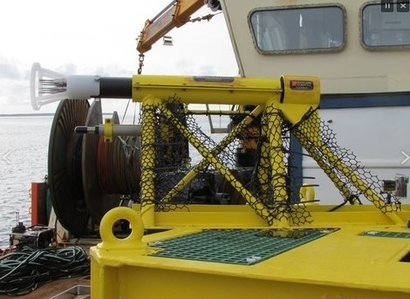
The pod has been fitted with an innovative turbulence instrument, a MicroRider turbulence system designed by Rockland Scientific, a Canadian company specialising in marine turbulence. The sensor system combines standard flow measurement technology (acoustic and electro-magnetic) with novel non-acoustic measurement technology (shear probes).
Integration of the new instruments on the pod has been made possible thanks to the InSTREAM (In Situ Turbulence Replication Evaluation And Measurement) project, funded through a transatlantic partnership between the Offshore Energy Research Association (OERA), a Nova Scotian not-for-profit research group, and Innovate UK, the UK Government’s business and innovation organisation. The project will enable tidal energy developers to optimise design so that technologies can withstand the effects of strong tides and currents, thereby aiming to acquire an improved understanding of turbulence.
Led by Rockland Scientific, the InSTREAM project brings together UK-based FloWave TT, Ocean Array Systems and EMEC, and Canadian companies Dalhousie University and Black Rock Tidal Power.
“The flow through tidal passages is, by nature, extremely turbulent and this flow speed variability affects the reliability and efficiency of tidal stream turbines” said Peter Stern, Vice President of Engineering at Rockland Scientific. “Accurate measurement and numerical modelling of turbulence is therefore vital for designing and deploying tidal technology, as well as assessing the risk and cost of operations. The InSTREAM project is addressing the shortcomings of existing measurement instrumentation to allow ‘real-world’ field measurements to be down-translated to tank-scale and vice-versa, providing developers and manufacturers the ability to evaluate the dynamic behaviours of sites and turbine designs at model scale and full-scale. The results from this applied research project will address technical challenges that ultimately reduce uncertainties in site design, yield assessments, and device design, reducing operational and economic risk”.
Donald Sinclair, Engineering Technician at EMEC, added that the pod was successfully deployed during a recent period of neap tides in a short weather window and is now feeding live data back to EMECs data control centres in Stromness and Eday via a subsea cable.
The project is being carried out in both UK and Canadian waters – at EMEC, and at FORCE in Nova Scotia, Canada. Tests have already been completed at the University of Edinburgh’s FloWave Ocean Energy Research Facility which can replicate tidal characteristics found at EMEC’s Fall of Warness tidal test site in Orkney where the Pod has been deployed. The site experiences tides of up to 4m/s, or eight knots, at peak tide.
The pod has been designed as a plug-and-play prototype with the ability to install additional sensors as required. In addition to the turbulence monitoring system, the Pod has undergone further improvements since it’s last deployment, with new Valeport current sensors installed alongside a recovery system developed by a local marine contractor, Leask Marine, which negates the need for divers operating in a tidal situation.
Image: Integrated Monitoring Pod with Rockland Scientific MicroRider turbulence system
For additional information:

